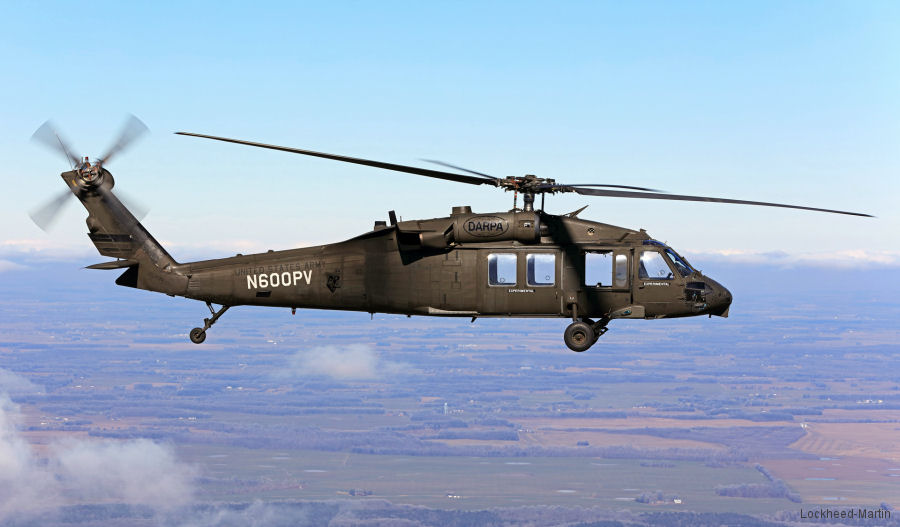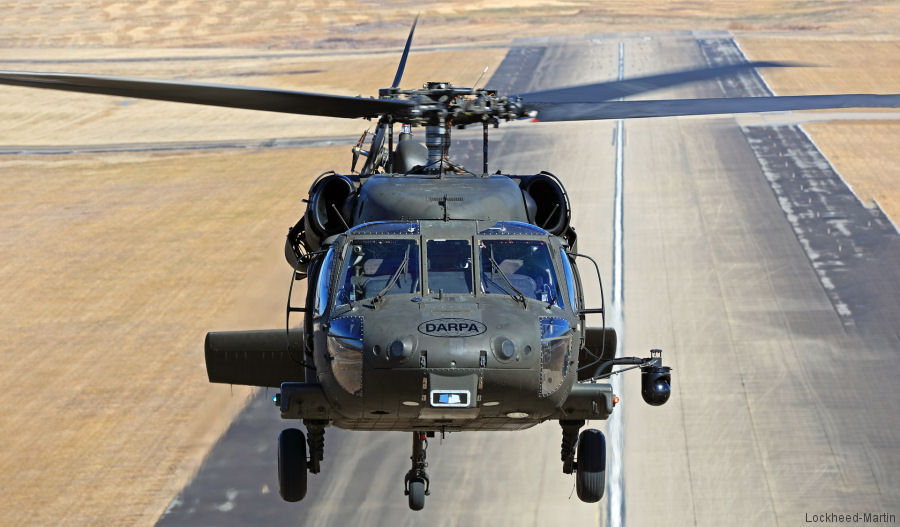
Moments later, the Model A Black Hawk aircraft, identifiable by DARPA’s logo and tail number N60-OPV, completes a pre-flight check list, starts its engines, spins up its rotors and takes off with no crew onboard. All of it happens fully autonomously
On a clear and cold morning, the autonomous Black Hawk, equipped with ALIAS (Aircrew Labor In-Cockpit Automation System) begins executing a 30-minute mission. To demonstrate its ability to adapt to a variety of mission environments, the uninhabited Black Hawk navigates at typical speed and altitude through a simulated cityscape, avoiding imagined buildings while route re-planning in real time. All the while, on-board sensor simulation provides real-time obstacle data.
The Black Hawk helicopter then autonomously executes a series of pedal turns, maneuvers and straightaways before completing a perfect landing. Once it shuts itself down, the two pilots approach and re-enter the aircraft. The OPV (optionally-piloted vehicle) switch is reversed from zero to two, and then the pilots taxi back down the runway.
“Lockheed Martin Sikorsky’s advancements in flight automation and autonomy will be game-changers for Army aviators and ground commanders, particularly as the Army looks to modernize its enduring helicopter fleet with Future Vertical Lift.” , said Jay Macklin, Sikorsky business development lead for Army, Future Vertical Lift, and Innovations programs
ALIAS (Aircrew Labor In-Cockpit Automation System)
“ALIAS represents a leap ahead in autonomy for a range of systems,” said Igor Cherepinsky, Director of Sikorsky Innovations at Lockheed Martin. “We began with the core architecture and software of Sikorsky’s MATRIX™ Technology to design extensible and flexible systems for ALIAS that have now flown on nine different military and commercial aircraft.
We are confident that this next generation of enhanced flight controls will create new approaches for the battlefield of the future and enable reliable commercial scenarios such as urban air mobility”.
This transformational technology equips crews to excel in difficult situations – or avoid them altogether, according to Jay Macklin, a retired U.S. Army Black Hawk pilot who now leads business development for Sikorsky’s Army, Future Vertical Lift, and Innovations programs.
“Sikorsky’s advancements in flight automation and autonomy will be game-changers for Army aviators and ground commanders, particularly as the Army looks to modernize its enduring helicopter fleet with Future Vertical Lift,” he said. “This transformational technology will provide commanders and aircrews with a strategic advantage in countering complex new threat environments.”
ALIAS technology and autonomy enable greater mission flexibility, increase safety and allow end users to reimagine how they can use air vehicles on current and future battlefields. The technology is not limited to a Black Hawk and is currently being incorporated into commercial and military fixed-wing aircraft. ALIAS will continue to advance optionally-piloted technology with two additional aircraft demonstrations in the coming months.
According to Dr. Stuart Young, the DARPA ALIAS Program Manager, “The potential for ALIAS to transform warfare is unlimited, whether we are talking about unmanned or manned platforms. By reducing workload, increasing safety, enabling new missions, these demonstrations show what ALIAS has to offer for transition to our services.”
ALIAS equipped Black Hawk helicopter completes first uninhabited flight
DARPA, February 8, 2022 - The DARPA Aircrew Labor In-Cockpit Automation System (ALIAS) program completed a first ever flight of a UH-60A Black Hawk helicopter without anyone onboard. Sikorsky, a Lockheed Martin company, completed 30-minutes of uninhabited flight with the optionally piloted vehicle (OPV) over the U.S. Army installation at Fort Campbell, Kentucky on February 5th. An additional uninhabited flight was also conducted on February 7th.
[Note: DARPA will hold a virtual press briefing at 11:00AM EST on Tuesday, February 8. DARPA’s ALIAS program manager and the director of Sikorsky Innovations will be available to answer questions. Media may receive an access link by contacting: [email protected]]
The Black Hawk was retrofitted with Sikorsky MATRIX™ autonomy technologies that form the core of ALIAS and can change the way aviators and air crews execute their missions by providing assistance when flying with limited visibility or without communications.
ALIAS is a flexible, extensible automation architecture for existing manned aircraft that enables safe reduced crew operations, which facilitates the addition of high levels of automation into existing aircraft. It also provides a platform for integrating additional automation or autonomy capabilities tailored for specific missions.
“With reduced workloads pilots can focus on mission management instead of the mechanics,” said Stuart Young, program manager in DARPA’s Tactical Technology Office. “This unique combination of autonomy software and hardware will make flying both smarter and safer.”
The ALIAS program has leveraged the considerable advances in aircraft automation systems over the past 50 years, as well as similar advances in remotely piloted aircraft. Even in today’s most automated aircraft, pilots must still manage complex interfaces and respond to unexpected situations.
ALIAS aims to support execution of an entire mission from takeoff to landing, including autonomously handling contingency events such as aircraft system failures. Easy-to-use interfaces facilitate supervisor-ALIAS interaction.
“With ALIAS, the Army will have much more operational flexibility,” said Young. “This includes the ability to operate aircraft at all times of the day or night, with and without pilots, and in a variety of difficult conditions, such as contested, congested, and degraded visual environments.”
The Army is currently exploring potential use cases for technologies such as ALIAS, including those outlined in the U.S. Army’s Future Vertical Lift (FVL) program.
Within the next month, the ALIAS program plans to conduct the first flight of a fly-by-wire M-model Black Hawk at Fort Eustis, Virginia.

On February 5, 2022 Sikorsky and DARPA made history flying a Black Hawk Helicopter completely autonomously
UH-60A Black Hawk N600PV ( Sikorsky Helicopters )
Comments | Join community |
| Incredible |
See also |
Sikorsky OPV Black Hawk
OPV Black Hawk with Supervised Autonomy




